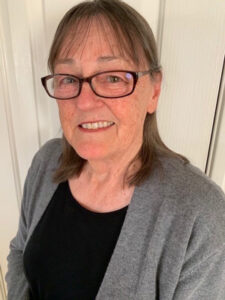Clinician Interview: Kaye Donec – diffusing tone, preventing breakage, and providing movement
Michelle L. Lange, OTR/L, ATP/SMS

Kaye Donec, former Individualized Services Team Leader of the Adult Therapy Program at the Disability Services Department of Communities
Kaye Donec has retired from her long-time position as Individualized Services Team Leader of the Adult Therapy Program at the Disability Services Department of Communities – a program coordinated through the Government of Western Australia. In this position, Kaye has used a lot of Dynamic Seating over the years! Given the time difference between Perth and Denver, Kaye graciously agreed to answer my questions via email.
How long have you been working with Dynamic Seating?
“I have been thinking about the possible use of dynamic components in seating for about 30 years, but early on it was only wishful thinking. Western Australia (WA) has a relatively small population and limited capacity to develop new innovations, relying heavily on imported products. I would say I have actually worked with dynamic components for just over 20 years. Initially ‘dynamic back support’ was only the flexibility of the back posts. Approximately 15 years ago, a dedicated dynamic back became available to us. It created a new dimension to what we were able to do and achieve.”
How were you using Dynamic Seating with the clients you served?
“Diffusing tone has been the main reason, usually supported by a high number of equipment breakage and repairs. Providing movement is gaining more importance as prescribing therapists have become more familiar with this indicator for dynamic component use.”
What Dynamic Seating components were you using?
“Dynamic back supports were by far the most common component being used. Dynamic head supports would be next, but few by comparison, followed by dynamic footrests. There were some issues with ordering compatible hardware for dynamic head supports, especially when the individuals were using head switches for communication devices.”
Have you had any difficulty with funding Dynamic Seating components?
“As far as I am aware, there have not been any difficulties funding dynamic supports, providing they are necessary to meet clearly defined client goals and sound clinical reasoning. We have been very fortunate in Western Australia (WA), as our funding has been quite generous and quick. There has been a recent change in funding within Australia with the introduction of a National Disability Insurance Scheme (NDIS). The roll into NDIS is only just being completed in WA. It appears that the process from scrutiny of assistive technology (AT) applications through to agreement to commit funds and order is slower. However, at this point, there have been very few irreversible ‘knock backs’” (or denials, as we refer to this in the States).
What is the clinician response to Dynamic Seating in your area?
“Clinicians have been positive about utilizing dynamic components in seating. I have been involved in education, consultation, and mentoring of clinicians. They have been receptive to the concepts and include them as part of their suite of techniques available to meet individual’s goals and needs. The more experienced clinicians have welcomed dynamic components as a way of solving ongoing and difficult problems they have faced with individuals. They have raised concerns about not being able to effectively trial dynamic head support and footrest components. Trialing of components has been emphasized as important evidence justifying prescription and, therefore, funding to NDIS.”
What feedback are you getting from families?
“Feedback from families and caregivers has been positive, including the user being able to maintain their position longer, being more comfortable, and not requiring repositioning as frequently.”
Do you have any other thoughts on Dynamic Seating?
“Product availability and education are important so that the supplier can give accurate advice to prescribing clinicians, including specifications. Delays caused by incorrect information and / or orders is frustrating for everyone as the process is already long. A knowledgeable supplier gives clinicians confidence in the product and its use. I think the ongoing use of Seating Dynamics’ information is good and its regular presentation keeps the use of dynamic components in a clinician’s repertoire.”
Thanks, Kaye for your years of experience and contributions to the clients you served! Enjoy your retirement!
